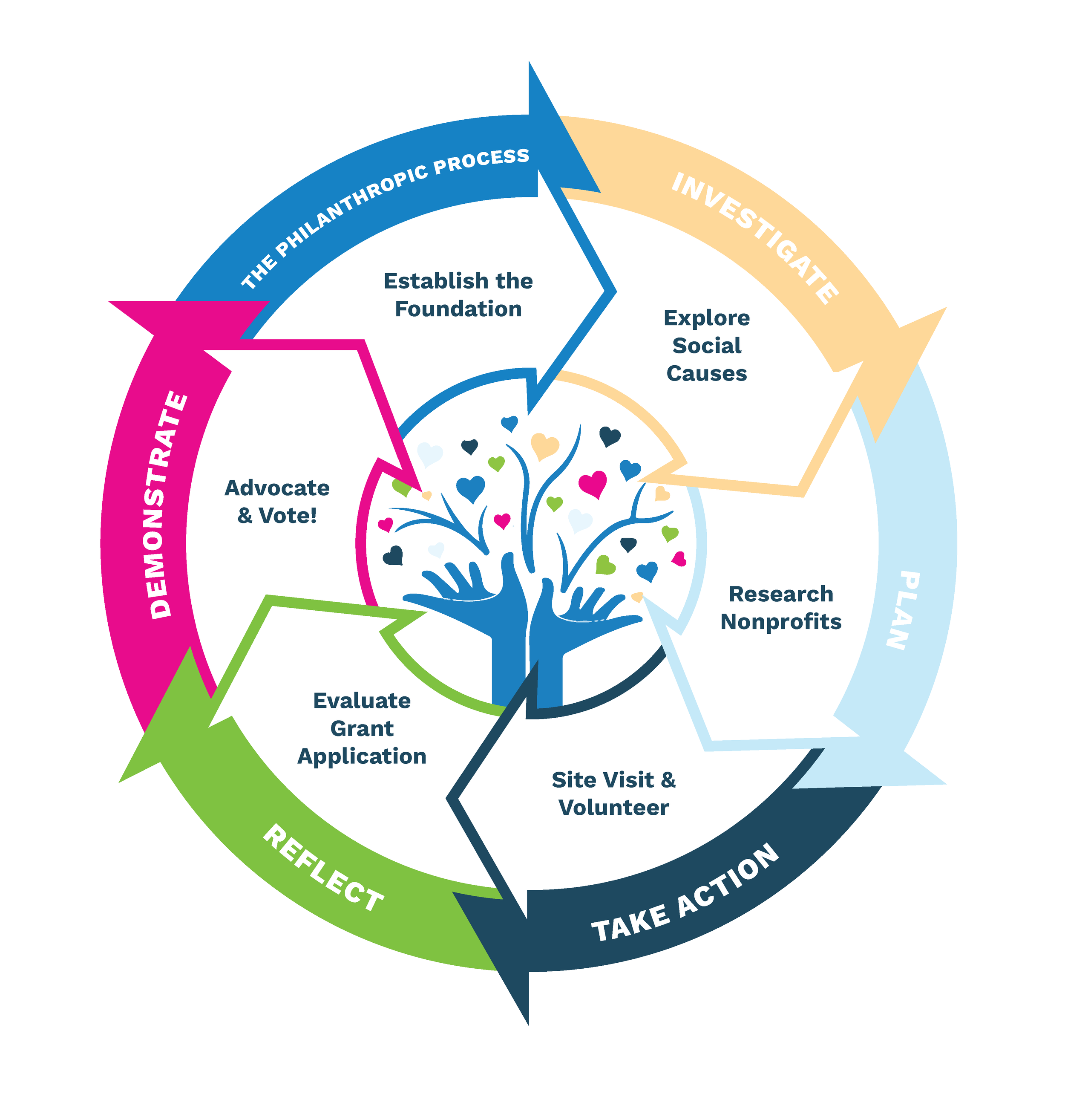Service-Learning Overview
What is Service-Learning by Magnified Giving?
Magnified Giving was founded in 2008 with the mission to educate, inspire and engage students in philanthropy, and to touch the hearts and minds of teens, lighten the concerns of others, and magnify the impact of philanthropy. One way we achieve our mission is by providing resources for service-learning, an approach to teaching and learning in which students use academic and civic knowledge and skills to address genuine community needs while achieving academic standards. The 6 Steps of the Magnified Giving Youth Philanthropy Program align with the service-learning process, so a deeper understanding of service-learning only increases the robustness of your philanthropy education practice. We offer training and resources on this educational approach not only to teachers who facilitate the Magnified Giving program, but to all educators and families in our region, because we know that this approach leads to greater engagement in service and problem-solving!
In 2018, the Mayerson Foundation passed on elements of their transformative Mayerson Service-Learning Program to Magnified Giving in order to continue the meaningful role of providing service-learning resources to teachers and community members. We are honored to continue this critical work to keep our community engaged in service, and we are thankful to be part of The Mayerson Foundation’s legacy of successful empowerment through service-learning.
What is Service Learning?
The service Learning method of instruction in which students actively participate in the learning process by identifying and meeting community needs while advancing the goals of a given curriculum. Through service-learning, students gain a deeper understanding of the course content, build strong community ties, and prosocial behaviors increase.
Service Learning is a five-part process (IPARD): Investigage, Plan, (take) Action, Reflect, Demonstrate & Celebrate!
Service Learning and Magnified Giving’s process is not another “thing” to teach, but another way of teaching and learning.
-
Investigate: Students identify community needs through discussion, research, or exploration.
-
Plan: Students identify action steps and communicate with a nonprofit to learn more about the nonprofit organization’s needs or identify a meaningful service project and develop a plan.
-
Take Action: Students implement the plan that they developed as a team, learn through the action of serving.
-
Reflect: Students examine the process as they gain a deeper understanding of themselves, their community, and give significance to the experience that will allow them to apply it to future actions. In meaningful service-learning students reflect and teachers assess student learning after each step, however, it is especially important after the action has been taken to implement student-led plans.
-
Demonstrate: Students apply knowledge, create a final project, fundraise, and share with peers and community.
Magnified Giving Programs
Magnified Giving utilizes service-learning as a method of instruction while providing an opportunity for students to explore the concept of becoming a philanthropist, now. Students learn to use their time and talent to serve their community and award a $1,000 grant to a local 501(c)(3) nonprofit provided by Magnified Giving.
-
Schools are offering Magnified Giving across an entire grade-level which allows the program to reach all students the school through one single subject, often allowing for curriculum crossover in other subjects in teaching teams. This process permits a school to magnify the impact on the students and the school culture by allowing, within multiple classrooms, a cross-education regarding the social cause selected and nonprofit agencies researched.
-
Schools are offering Magnified Giving across an entire grade-level which allows the program to reach all students the school through one single subject, often allowing for curriculum crossover in other subjects in teaching teams. This process permits a school to magnify the impact on the students and the school culture by allowing, within multiple classrooms, a cross-education regarding the social cause selected and nonprofit agencies researched.
-
Magnified Giving programs can be implemented in core-curriculum courses or in an elective. Regardless of the subject, the real-world connection of the program allows for students to gain skills and apply knowledge as they explore how our communities work. Teachers guide students, empowering them to follow their passions while meeting benchmarks throughout a unit, semester, or year-long program.
-
A Magnified Giving program within an extracurricular club allows the school to design the flow of the program to best fit the culture of their school, and open to a wide variety of students. The Magnified Giving program is implemented in Key Club, National Honor Society, or as a separate Philanthropy Club, or extracurricular activities offered to students. We also encourage student led-initiative programs and only ask for adult support to help keep the process moving forward as needed.
By facilitating Youth Philanthropy Programs and supporting strong service-learning practices, we empower youth to:
Explore social issues that matter to them.
Engage with nonprofit organizations, volunteering, or conducting a site visit to find out more about their mission and why the work they do is essential to their community.
Use their voice to advocate and vote for one or more nonprofits to receive grant funds based on what they learned from their grant application and personal experience.
Understand Impact by asking the nonprofit organization to submit a grant proposal for $1,000 or more if the students choose to fundraise additional funds, as well as the value of volunteering or advocating for an organization or social cause. Analyze what impact their grant could make to that organization.
Reflect on why their actions matter and what the youth philanthropy experience means to them, the nonprofit organizations, and the community.
Celebrate the learning process and award the $1,000 grant to the 501(c)(3) nonprofit organization at the annual Giving Ceremony events.
We do this through a six-step program implemented by teachers that connect donors, students, teachers, and nonprofit organizations.




